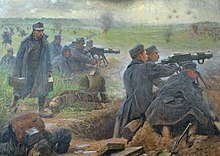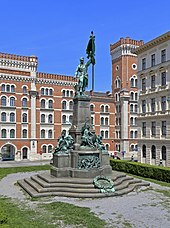Imperial and Royal Infantry Regiment "Hoch- und Deutschmeister" No. 4
|
" Teutschmeister on foot ", 1717 " Teutschmeister infantry ", " kuk infantry regiment" Hoch- und Deutschmeister "No. 4 " |
|
|---|---|
 Regiment Teutschmeister in 1762 - contemporary Albertina manuscript, Vienna |
|
| active | 1696 to 1918 |
| Country | Holy Roman Empire of the German Nation : Imperial Army / Habsburg Monarchy , 1804 Austrian Empire , 1867 Austria-Hungary |
| Branch of service | infantry |
| Origin of the soldiers | from the entire empire , from 1766: Lower Rhine-Westphalian Imperial Circle , Imperial Cities of the Lower Saxon Imperial Circle and Franconian Imperial Circle (esp. Franconian Order of the German Order ) |
| owner | 1696 Franz Ludwig von der Pfalz , 1731 Clemens August von Bayern , 1761 Carl Alexander von Lothringen , 1780 (Archduke Maximilian of Austria) , 1801 Archduke Karl of Austria , 1805 Archduke Anton Victor |
| Tribe list | List of infantry regiments of the Imperial Habsburg Army in the early modern period |
| Trunk number | 1769: No. 4th |


The later Imperial and Royal Infantry Regiment Hoch- und Deutschmeister No. 4 , founded as the imperial regiment Teutschmeister on foot in 1696 ; colloquially short, high and German master was an Infantry - Regiment of the Imperial Habsburg and later the Austro-Hungarian Army .
history
Beginnings
The regiment was set up in 1696 by a treaty between Emperor Leopold I and the Grand Master of the Teutonic Order , Franz Ludwig von Pfalz-Neuburg , and was first called " Pfalz-Neuburg -Teutschmeister", but was soon only called "Teutschmeister". The regiment was recruited in Franconia and gathered in Donauwörth to be accepted into imperial service on June 3, 1696.
The regiment took part in the Great Turkish War and was deployed in Transylvania for most of the time . On September 11, 1697, the Teutschmeister regiment fought its first major battle near Zenta . The regiment distinguished itself in such a way that the emperor issued a letter of thanks and recognition to the regiment commander at the time, Damian Hugo Freiherr von Viermund zu Neersen , on the report of Prince Eugene . In 1717, in the Battle of Belgrade , the commander Damian Casimir von Dalberg fell . In the Seven Years' War the regiment took part in the Battle of Kolin in 1757 , which is also where its traditional day, June 18, 1757, can be traced back. After this war, the area of the Vienna Woods and the Vienna suburbs were assigned to the regiment for advertising, after which it developed into the Vienna House Regiment. Upon introduction of the strain numbers for infantry regiments in 1769, the regiment received the # 4. Owner of the regiment was the respective Order Grand Master, whose term 1530-1929 colloquially " High and German Masters " was named so in 1814 the regiment name officially in "Construction and Deutschmeister ”was changed. After the order had lost its sovereignty in 1806, it was held by a Habsburg archduke until 1918 .
In August 1914, shortly before the beginning of World War I , the regiment (95% Germans) belonged to the II Army Corps and was stationed in Vienna. The commandant was Colonel Baron Ludwig von Holzhausen.
In 1915 all regiments lost their additional and honorary names and were only named after their trunk number. From then on, the regiment was officially called Infantry Regiment No. 4.
Stationing locations
|
|
|
Association tradition after 1918
For reasons of tradition, later units were also given the honorary name “Hoch- und Deutschmeister”. In the Armed Forces of the First Austrian Republic , the 4th Infantry Regiment was given the traditional name “Hoch- und Deutschmeister”.
During the Second World War , the 44th Reich Grenadier Division Hoch- und Deutschmeister carried this nickname, with the 3rd Battalion of Grenadier Regiment No. 134 being one of the few units of the German Wehrmacht to carry a separate flag. It was modeled on the troop flag of the former Austro-Hungarian Army.
The traditional military bearers in the Austrian Armed Forces of today's republic were initially the Landwehr Trunk Regiment 21 (then as Jägerregiment 2 of the 2nd Jägerbrigade) and then until its dissolution in the summer of 2006 the Jägerregiment Vienna. Since then, the tradition of the Jägerbataillon Wien 1 "Hoch- und Deutschmeister" , an association of the Austrian militia, has been continued .
Deutschmeisterdenkmal
In 1876 the Deutschmeisterplatz in Vienna's Inner City (1st district) was named after the regiment. On the occasion of the celebration of the regiment's 200th anniversary in 1896, the Deutschmeister monument was donated to him on this square . This was unveiled on September 29, 1906. On the front of the relief the " Baptism of Fire at Zenta 1697 " and on the back the " Count Soro bei Kolin 1757 " is shown.
Deutschmeisterbund
Former members of the regiment and its successor or traditional troop units of the first republic as well as the German master clubs that are part of the regiment tradition are called German champions. Some of these associations have existed since the end of the 19th century and are united in the Deutschmeisterbund under the protectorate of the Grand Master of the Teutonic Order. This umbrella organization ( motto : “Deutschmeister is and remains one” ) was founded in 1986 and is based in Vienna. Such an umbrella organization already existed from 1919 to 1945 and from 1956 to 1974 with the same name and headquarters.
Member associations in Austria are:
- Club Hoch- und Deutschmeister IR 4
- German master rifle corps
- "kuk Wiener Regimentskapelle IR4" - kuk Wiener Regimentskapelle IR4
- Comradeship of the members of the former 2nd Division of the Austrian Armed Forces and the former 44th Infantry Division, later Reichsgrenadier Division, Hoch- u. Deutschmeister '
- Association of Friends of the Jäger Battalion VIENNA 1 "Hoch- und Deutschmeister"
- Deutschmeister 1809 Infantry Regiment No. 4 in Perchtoldsdorf
- Original Hoch- und Deutschmeister "Original Hoch- und Deutschmeister" band of the K. and K. Infantry Regiments Hoch and Deutschmeister No. 4
In Germany, for example, the federal government includes:
- Historical German Order Compagnie zu Mergentheim e. V.
- Teutonic Order Chapel Ellingen e. V.
- Freundeskreis Hoch- und Deutschmeister Mannheim (founded in 1989, member since 1995, left in 2010)
The German Masters meet every year on St. George's Day in the old residence of their protector in Bad Mergentheim . The color they have in common to this day is light blue as the regiment's old equalization color . It can still be found today in the badge of the Deutschmeisterbund, as well as in its decorations and in traditional uniforms.
The Deutschmeisterbund maintains contact with the traditional bearer of the regiment in the armed forces as well as with the Teutonic Order, and in addition to the “Deutschmeisterjournal” issues other publications in loose succession. In addition, he awards the four-tier "Badge of Honor of the Deutschmeisterbund", which is approved by the Austrian Ministry of Defense for wearing on the uniform (although it is non-governmental) for special services to the German championship tradition .
Picture gallery
Known members of the regiment
- Damian Hugo Freiherr von Viermund zu Neersen (1666–1722)
- Johann Strauss (father) (1804-1849), musician, composer, served in the regiment
- Raimund Dorner (1831-1917), Colonel and Commandant
- Edward Rydz-Śmigły (1886–1941), Marshal of Poland , served in the regiment from 1910 to 1911;
- Dominik Ertl (1857–1911), musician, composer, served in the regiment
- Wilhelm August Jurek (1870–1934), musician, served in the regiment from 1891–1894;
- Hans Moser (1880–1964), actor, served in the regiment from 1910–1912 and from 1914–1918;
- Hugo Flink (1879–1947), actor
Media reception
In addition to the films Spring Parade (1935) and Die Deutschmeister (1955), the regiment also left its mark on music :
- German master regimental march by Wilhelm August Jurek (1870–1934)
- German Champion March by Josef Bayer (1852-1913)
- High and German Masters by Dominik Ertl (1857–1911)
- German master greeting polka by Dominik Ertl
- Deutschmeister Jubilee March , Op. 470 by Johann Strauss Sohn (1825–1899)
See also
- List of infantry regiments of the Imperial Habsburg Army in the early modern period
- List of kuk combat troops
literature
- Deutschmeisterbund (ed.): The present and history of the Deutschmeistervereine. Self-published, Vienna 1996.
- Deutschmeisterbund (Ed.): 300 years of regiment Hoch- and Deutschmeister 1696–1996. Self-published, Vienna 1996 (2nd edition Vienna 1999).
Web links
- Entry on Kuk infantry regiment "Hoch- und Deutschmeister" No. 4 in the Austria Forum (in the AEIOU Austria Lexicon )
- The Deutschmeisterdenkmal in Vienna
- The regiment in the First World War
- The Deutschmeister regimental march
- Friends of Hoch- und Deutschmeister Mannheim / Baden
- German master rifle corps
- Deutschmeisterbund
- Original high and German masters
- kuk Wiener regimental band IR4
Footnotes
- ↑ http://www.bundesheer.at/sk/lask/baone_miliz/jgbw1.shtml
- ↑ founded May 3rd, 1977 - register of associations ZVR 397320513
- ↑ founded on May 6, 1977 - register of associations ZVR 385688411






